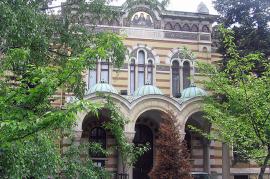Author Leah Cohen published a new book about the Holocaust and the fate of the Bulgarian Jews. Here we present you with an excerpt from chapter You Believe. In the box below you will find the full text.
The Bulgarian Orthodox Church
In the debate on the fate of Jews, it was confronted by a well organized state machine, which it tried to influence by nonstandard means of communication between Church and State: a continuous pressure already at the discussion of the ‘Law on the Protection of the Nation’, which it strongly disagreed with, a pressure that it continued with, till the complete abolition of the anti-Jewish actions after September 2, 1944.
Throughout all this period the Church used to be in complex and contradictory relations with the Palace and the government that refused to grant it the right of electing a patriarch. Representatives of the higher clergy as Bishops Stefan and Cyril had overt conflicts with Czar Boris the Third, both on ecclesiastical issues, and due to disagreement with his pro-German policy. Without taking into consideration that they put in jeopardy the inner Church policy, the Bulgarian bishops made a moral choice regarding the Jewish question in Bulgaria, of which could not brag about, neither any religious institutions in Europe of that time, nor any other official organization, in general. Moreover, its unprecedently consistent position was not exhausted with humanistic appeals only, but was also expressed by actions, illustration of which gave Church leaders themselves. Episodes like the ostentatious taking under protection of the Sofia and Plovdiv Rabies, respectively by Bishop Stefan and Bishop Cyril, the dramatic letters and telegrams, sent by both of them to the Monarch, demanding the deportation cancellation, the threat of Cyril that he will get on trains together with the Jews, the written order to priests “to open up the doors of churches and monasteries for the Jews”, are not urban legends and secondarily created myths, but real facts, accomplished with vigor and certain histrionics. Namely the emotional effect of these reactions had stimulated the population, which, fascinated by its clerics, had unified around them in an action that had transformed in a cause at an instant. It’s an amazing fact that the 11 Bulgarian Bishops, in spite of all contradictions, differences and sometimes conflicts within them, have managed to come to consent about their collective resistance against the anti-Jewish legislation and later against its implementation and the persecutions that followed. A testimonial about the Church struggle for protecting at first the rights and later the life of the Jewish population, are the Holy Synod protocols for the period 1940-1944, a document with amazing content, whose publication in 2002 has given a new direction to the whole “theory of saving”. Everyone knowledgeable understands that the true moral leaders of the saving were the Bishops , who have exercised influence and power both over the ruling circles and for the unification of considerable, by their numbers, groups of people, where they were well esteemed. Thus, they carried into effect not only forms of protest, but real public civil disobedience that threatened the pillars of kingdom and power, shaking them from within and as a result forcing them towards a sole possible in that moment choice: deportation abrogation, although temporary. Government and Palace reacted to these actions with overt hostility: according to Stefan Gruev the Czar was very angry and was even inclined to accuse Bishop Stefan of espionage in favor of the British, as to Bogdan Filov, in his “Diary” the prime-minister again lost his temper with the priests. With a proved success, this method of crude and unambiguous pressure over authorities has been applied afterwards, each time there was a new threat of deportation, sabotaging authorities’ intentions and depriving them of popular support for their anti-Jewish actions. It has to be emphasized here that Jewish intellectuals were well esteemed. Examples are Pancho Vladigerov, author of the strongly patriotic “Bulgarian Rhapsody Vardar” (1922), composed as reverberation of the Bulgarian national propensities after the Treaty of Neuilly, the painters Jules Pascin, David Peretz, and many others.
However, due to the media censorship (newspapers and radio were all governmental) the intellectuals’ protests did not find wide response.
A review of the newspapers between the autumn of 1940, when the Draft ‘Law on Protection of the Nation’ was introduced to the National Assembly, and March 1943, which is a tragic boundary for Jews’ fate, shows that public interest indifferently winded around Jewish persecutions. One can’t even claim that there was a particularly aggressive anti-Semitic propaganda to prepare the public for the afflictions, planned by authorities. Newspapers “Mir”, “Zora”, “Utro” and others, informed the population of the war actions’ course, exercised their apologetics of the Germans, but didn’t indulge into virulent attacks towards Jews. In February 1943, only a month before the planned deportation of Jews, in “Mir” newspaper one could even find Jewish engagement and wedding announcements, and among advertised newly published books – a biography of Albert Einstein, who had long before left Germany to avoid concentration camps.
[translation by Eleonora Elbaz]


https://en.gariwo.net/righteous/shoah-and-nazism/the-bulgarian-orthodox-church-and-the-rescue-of-jews-6184.html
The Bulgarian Orthodox Church and the rescue of Jews
article by Leah Cohen
23 November 2012

